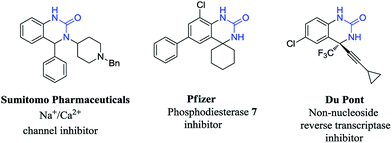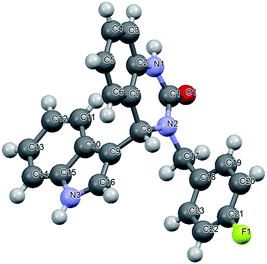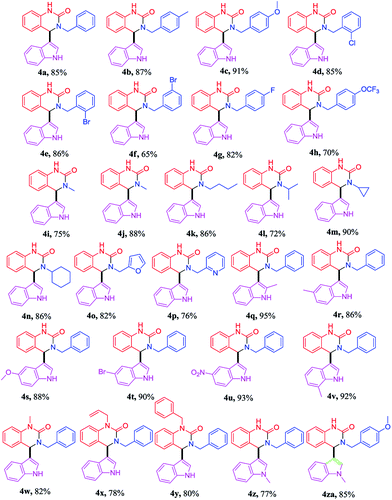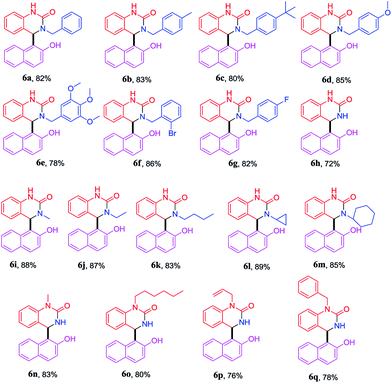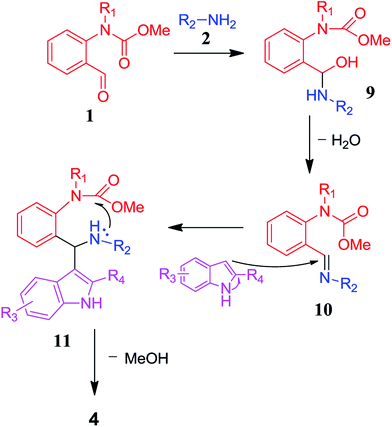Hydrophobically directed, catalyst-free, multi-component synthesis of functionalized 3,4-dihydroquinazolin-2(1H)-ones†
Daggupati V. Ramanaa,
B. Vinayaka,
V. Dileepkumarb,
U. S. N. Murtyb,
L. Raju Chowhanc and
M. Chandrasekharam*a
aI&PC Division, CSIR-Indian Institute of Chemical Technology, Uppal Road, Tarnaka, Hyderabad-500 007, India. E-mail: chandra@iict.res.in
bBiology Division, CSIR-Indian Institute of Chemical Technology, Uppal Road, Tarnaka, Hyderabad-500 007, India
cSchool of Chemical Sciences, Central University of Gujarat, Gandhinagar-382030, India
First published on 17th February 2016
Abstract
A one-pot three-component reaction of o-formyl carbamate, a primary amine, a nucleophile (1H-indole or 2-napthol) in water generated a variety of functionalised 3,4-dihydroquinazolin-2(1H)-one derivatives. The reaction operated under catalyst-free conditions involves a Mannich type reaction followed by intramolecular cyclization and produced good to excellent yields of the products with a wide range of substrates. The environmentally benign multi-component reaction is a sustainable approach to the library of 3,4-dihydroquinazolin-2(1H)-one derivatives under completely neutral conditions. All the newly synthesized compounds were evaluated for their antimicrobial activity against Gram positive bacteria and Gram negative bacteria. Nineteen compounds exhibited good antibacterial activity against both Gram positive pathogens and Gram negative species.
Introduction
Organic transformations, when performed in water, offer several “green chemistry” benefits such as low cost and the lack of inflammability, explosive, mutagenic and carcinogenic properties.1 The unique characteristics of the universal solvent, including the hydrophobic effect,2 enhanced hydrogen bonding in the transition state,3 and the high cohesive energy density4 can dramatically influence the transformations performed in this media. In drug discovery programmes, synthesis of drug-like compound libraries with high levels of molecular complexity and diversity is a challenging and time consuming task and in this connection, multi-component reactions (MCRs) are found to be a convenient alternative.5 Recently the design of new MCRs with green approaches evolved as efficient protocols for the synthesis of complex molecules especially in the areas of drug discovery, organic synthesis, and material science.6 Furthermore, MCRs are known to exhibit negative activation volumes owing to the condensation of several molecules into a single reactive intermediate and product and hence can be accelerated in water.7 Water as a reaction medium not only accelerates MCRs but also facilitates the ready isolation of the products, often insoluble in the medium.Recently there has been a surge in interest for the development of new synthetic methods for the efficient preparation of 3,4-dihydroisoquinazolinone heterocycles because of the presence of this scaffold in a wide range of bioactive molecules administered for the treatment of convulsive disorders,8 inflammatory diseases,9 infectious diseases,10 autoimmune diseases11 and cardiovascular conditions12 (see Scheme 1). Given the success of hydrophobically directed organic synthesis13 in MCRs where hydrophobic interactions function as a nonbonding element of control for synthetic reactions in water, we intended to explore its fullest potential and scope for the synthesis of the substituted quinazolinones alkaloids.14
The majority of literature for the synthesis of 3,4-dihydroquinazolinone hetero-cycles involves construction of a pyrimidinone ring on a phenyl ring rather than the construction of the phenyl ring on ready-made pyrimidinone. Apart from several other methods, the employment of Grignard reagents, Rh-catalysts, Villsmeier–Hack conditions have been thoroughly studied. However the MCR protocol, investigated by Luke R. Odell et al. is the most efficient synthesis for this class of compounds.15
Recently, an organo-catalyzed enantioselective approach for the synthesis of biologically important chiral trifluoromethyl dihydroquinazolinones has been reported.16 Despite exhaustive investigations into the construction of 3,4-dihydroquinazolinone heterocycles, the lack of highly demanding green approaches warrants re-invention. Our ongoing research on green technologies for C–H functionalization and their application in the construction of bioactive compounds inspired us to take up this present study whereby the MCR of o-formyl carbamate, amine and a nucleophile, follows a Mannich type reaction/intramolecular cyclization sequence. Our reaction protocol highlights a clean and green method involving hydrophobically directed catalyst free MCR under completely neutral conditions and produced highly substituted 3,4-dihydroquinazolinones in good to excellent yields. Given their biological relevance, significant effort has been directed towards the synthesis of 3,4-dihydroquinazolinones. Furthermore, the importance of 1H-indoles is well recognized by synthetic as well as biological chemists.17 Therefore the preparation of indole substituted 3,4-dihydroquinazolinone derivatives and their antibacterial activities has attracted our attention and in this context we herein report the MCR of o-formyl carbamate, amine, and indole as well as 2-naphthol in water under catalyst free conditions. All the new compounds were characterised using IR, 1HNMR and 13CNMR spectroscopy, HRMS and the analogous 4g was unambiguously confirmed by single crystal X-ray analysis (Fig. 1).21 Selected synthesized compounds were studied against the bacterial strains Staphylococcus aureus (MTCC 96), Staphylococcus epidermidis, Bacillus subtilis (MTCC 441) and Gram-negative organisms viz Escherichia coli (MTCC 443), Pseudomonas aeruginosa (MTCC 741), and Klebsiella pneumoniae (MTCC 618).
Results and discussion
Optimization of the reaction conditions
Initially, the reaction of methyl (2-formylphenyl)carbamate 1a (0.55 mmol), benzyl amine 2a (0.60 mmol), and 1H-indole 3a (0.55 mmol) was performed in AcOH at 130 °C for 12 h under catalyst free conditions. The desired 3-benzyl-4-(1H-indol-3-yl)-3, 4-dihydroquinazolin-2(1H)-one 4a was obtained in 55% yield. Next, we further optimized the reaction conditions on this model reaction, and the results are summarized in Table 1. Various organic solvents, such as MeOH, ACN, DCM, toluene, DMF, DCE, 2-propanol and THF have been applied and unfortunately, only low to moderate yields (15–70%) of the desired product 4a were obtained (Table 1, entries 2–9). We then attempted to carry out the reaction of o-formyl carbamate 1a, benzyl amine 2a, and 1H-indole 3a using water as the reaction medium under catalyst free conditions. To our delight, this three-component reaction could proceed smoothly to obtain the corresponding product 4a in high yield (85%). Moreover, the reaction time (Table 1, entry 10) in water was shorter than in organic solvents (Table 1, entries 1–9). It is worth noting that the product 4a could be obtained simply by filtration from the reaction medium. The results revealed that water was the best reaction medium and the probable reason for this could be that the product which is insoluble in water could easily precipitate in the reaction medium, which would promote the movement of the chemical equilibrium toward the direction of products.| Entry | Solvent | Temp. (°C) | Time (h) | Yield of 4ab (%) |
|---|---|---|---|---|
| a Conditions: o-formyl carbamate 1a (0.55 mmol), benzyl amine 2a (0.60 mmol), and 1H-indole 3a (0.55 mmol), solvent (2 mL).b Isolated yields: all reactions performed in a sealed vessel.c Reaction performed in a 10 mL round bottom flask.d No product. | ||||
| 1 | AcOH | 130 °C | 12 | 55 |
| 2 | MeOH | 130 °C | 12 | 58 |
| 3 | ACN | 130 °C | 12 | 25 |
| 4 | DCM | 130 °C | 12 | 45 |
| 5 | Toluene | 130 °C | 12 | 15 |
| 6 | DMF | 130 °C | 12 | 30 |
| 7 | DCE | 130 °C | 12 | 68 |
| 8 | 2-Propanol | 130 °C | 12 | 20 |
| 9 | THF | 130 °C | 12 | 50 |
| 10 | Water | 130 °C | 8 | 85 |
| 11 | Water | 130 °C | 8 | 80c |
| 12 | Water | Reflux | 15 | 55c |
| 13 | Water | 80 °C | 15 | 20c |
| 14 | Water | RT | 24 | —d |
Furthermore, to optimize the reaction temperature, we carried out the reaction temperature under reflux, at 80 °C and at RT (Table 1, entries 12–14) using water as the reaction medium and found that the yield of the desired product 4a improved and the reaction time was shortened with an increase in the temperature. When the reaction was carried out in an open flask under reflux under all other identical conditions, the yield of the product 4a somewhat decreased to 80% (Table 1, entry 11). The reaction performed with 1 mmol of the substrate in 10 mL (excess) of water did not affect the product yield while under neat conditions, the yields were poor. Therefore, the best reaction conditions were found to be in water (2 mL/0.55 mmol) at 130 °C in a closed tube.
Substrate scope
To explore the scope and generality of the present method, different amines and indoles were selected to undergo this one-pot three-component reaction under catalyst free conditions in water. As shown in Table 2, a variety of amines, including aryl-alkylamines, NH4OAc, alkylamines, alicyclicamines, and heteroaryl-alkylamines were examined and the results clearly indicated that all the amines could react smoothly to obtain the corresponding products (Table 2, 4a–4p) in good to excellent yields (70–91%), except (3-bromophenyl)methanamine (4f, 65%).Next, we proceeded to examine the substituent effect of the 1H-indole unit on this reaction. It is worth noting that the effect of the nature of the substituents on both six- and five-membered rings of 1H-indole unit showed no obvious effect, because they were obtained in high yields (86–95%) (Table 2, 4q–4v). Furthermore, we investigated the effect of substitution in the N-1 position of the o-formyl carbamate component. Carbamates bearing alkyl, allyl, and benzyl substituent’s at the N-1 position (Table 2, 4w–4y) were cyclized in very good yields (78–82%). Methyl substituted indole also proceeds by this MCR with different benzyl amines and 1a.
Furthermore, we also used 2-naphthol 5 as a starting material to replace 1H-indole, and the reaction was carried out with different amines and N-1 substituted o-formyl carbamate components in water at 130 °C for 8 h in a closed vessel. The desired 4-(2-hydroxynaphthalen-1-yl)-3,4-dihydroquinazolin-2(1H)-one derivatives could be obtained in good to very good yields (72–88%) (Table 3, 6a–6q). We also tried 1H-pyrrole 7 in place of 1H-indole and obtained the desired product 8 in 78% yield (Scheme 2).
Anti bacterial activity
In vitro antibacterial activity of the newly synthesized compounds was studied against the bacterial strains Staphylococcus aureus (MTCC 96), Staphylococcus epidermidis and Bacillus subtilis (MTCC 441) and Gram-negative organisms viz Escherichia coli (MTCC 443), Pseudomonas aeruginosa (MTCC 741), and Klebsiella pneumoniae (MTCC 618), using an agar well diffusion method.18The minimum inhibitory concentrations (MIC) of various synthetic compounds were tested against three representative Gram-positive organisms viz. Staphylococcus aureus (MTCC 96), Staphylococcus epidermidis and Bacillus subtilis (MTCC 441) and Gram-negative organisms viz Escherichia coli (MTCC 443), Pseudomonas aeruginosa (MTCC 741), and Klebsiella pneumoniae (MTCC 618) using the microdilution method recommended by CLSI standard protocol19 in liquid medium (nutrient agar) distributed in 96-well plates. Serial dilutions of the tested compounds were performed (concentrations from 150 μg mL−1 to 0.97 μg mL−1) in 200 μL culture medium final volume. Afterwards each well was seeded with a 50 μL microbial suspension of 0.5 MacFarland density.
The selected compounds 4 and 6 (Table 4) were tested for antibacterial activities for all four bacterial strains. The compounds exhibited antibacterial activity against Gram-positive and Gram-negative bacterial strains with zones of inhibition ranging to a maximum of 21 mm. Compounds 4d, 4e, 4o, 4q, 4s, 6f and 6p were identified as potent antibacterial agents against Gram-positive bacterial strains where as the compounds 4a–4c, 4f, 4n, 4r, 4w and 4y were identified as potent antibacterial agents against Gram-negative bacterial strains. Compounds 4k–4m, 6a–6d and 6i–6k were identified as potent antibacterial agents against Gram-positive and Gram-negative bacterial strains while compounds 4g, 4j, 4p, 4t–4u and 6m–6n were not identified as potent antibacterial agents (Table 4). The MIC values for compounds 4a–4y, 6a–6p and for the positive control drugs penicillin and streptomycin were also determined against the six bacterial strains.
| Compound | Minimum inhibitory concentration | |||||
|---|---|---|---|---|---|---|
| Gram-positive organisms | Gram-negative organisms | |||||
| Staphylococcus aureus | Staphylococcus epidermidis | Bacillus subtilis | Escherichia coli | Pseudomonas aeruginosa | Klebsiella pneumonia | |
| 4a | >150 | >150 | >150 | 150 | >150 | >150 |
| 4b | >150 | >150 | >150 | 37.5 | >150 | >150 |
| 4c | >150 | >150 | >150 | 75 | >150 | >150 |
| 4d | >150 | >150 | 75 | >150 | >150 | >150 |
| 4e | 150 | >150 | >150 | >150 | >150 | >150 |
| 4f | >150 | >150 | >150 | 37.5 | >150 | >150 |
| 4g | >150 | >150 | >150 | >150 | >150 | >150 |
| 4h | >150 | >150 | >150 | 150 | >150 | >150 |
| 4j | >150 | >150 | >150 | >150 | >150 | >150 |
| 4k | >150 | >150 | 37.5 | 75 | >150 | >150 |
| 4l | 37.5 | 37.5 | 37.5 | 37.5 | >150 | >150 |
| 4m | 75 | 75 | 18.75 | 37.5 | >150 | >150 |
| 4n | >150 | >150 | >150 | 37.5 | >150 | >150 |
| 4o | 150 | >150 | 37.5 | >150 | >150 | >150 |
| 4p | >150 | >150 | >150 | >150 | >150 | >150 |
| 4q | 150 | >150 | >150 | >150 | >150 | >150 |
| 4r | >150 | >150 | >150 | 37.5 | >150 | >150 |
| 4s | >150 | >150 | 37.5 | >150 | >150 | >150 |
| 4t | >150 | >150 | >150 | >150 | >150 | >150 |
| 4u | >150 | >150 | >150 | >150 | >150 | >150 |
| 4v | >150 | >150 | >150 | >150 | >150 | >150 |
| 4w | >150 | >150 | >150 | 150 | >150 | >150 |
| 4y | >150 | >150 | >150 | 75 | >150 | >150 |
| 6a | >150 | 37.5 | >150 | 37.5 | >150 | >150 |
| 6b | >150 | 75 | 37.5 | 37.5 | >150 | >150 |
| 6c | >150 | 150 | >150 | 150 | >150 | >150 |
| 6d | >150 | 75 | >150 | 37.5 | >150 | >150 |
| 6f | >150 | 37.5 | >150 | >150 | >150 | >150 |
| 6g | 18.75 | 18.75 | 18.75 | 18.75 | >150 | >150 |
| 6h | >150 | 18.75 | 37.5 | 37.5 | >150 | >150 |
| 6i | 18.75 | 75 | 18.75 | 75 | >150 | >150 |
| 6j | 37.5 | 37.5 | 18.75 | 37.5 | >150 | >150 |
| 6k | >150 | 37.5 | 37.5 | 75 | >150 | >150 |
| 6m | >150 | >150 | >150 | >150 | >150 | >150 |
| 6n | >150 | >150 | >150 | >150 | >150 | >150 |
| 6p | >150 | 37.5 | 18.75 | >150 | >150 | >150 |
| Penicillin | 1.562 | 3.125 | 1.562 | 12.5 | 12.5 | 6.25 |
| Streptomycin | 6.25 | 3.125 | 6.25 | 6.25 | 1.562 | 3.125 |
Probable mechanism for the condensation
A plausible mechanism for the formation of 4-(1H-indol-3-yl)-3,4-dihydroquinazolin-2(1H)-ones 4 is depicted in Scheme 3. In the initial step, amine 2 attacks the carbonyl of aldehyde 1 to form intermediate 9, which is dehydrated to imine 10. Imine 10 is added to indole 3 to form Mannich product 11, followed by intramolecular cyclization to afford the product 4 (Scheme 3).Conclusions
In conclusion, we have developed a novel and efficient method for the synthesis of 4-(1H-indol-3-yl)-3,4-dihydroquinazolin-2(1H)-ones and 4-(2-hydroxynaphthalen-1-yl)-3,4-dihydroquinazolin-2(1H)-ones derivatives via the three-component reaction of o-formyl carbamate, primary amine and 1H-indole or 2-naphthol in water under catalyst-free conditions. The reaction is tolerant to a variety of substitutions of the carbamate, amine and indole. The advantages of this present methodology are high yields, mild reaction conditions, little environmental pollution, catalyst free and operational simplicity. Therefore, it is a useful method for the preparation of these compounds. Moreover, our observation that 2-napthol substituted 3,4-dihydroquinazolin-2(1H)-ones derivatives showed potential antibacterial activities compared to indole substituted derivatives directed us to further investigate this class of biologically active compounds.Experimental
General methods
Analytical thin-layer chromatography was performed using silica gel 60 F-254 plates and visualized under UV light or ninhydrin stain. Flash column chromatography was performed using silica gel (60, particle size 40–63 nm). IR spectra were recorded using a FT-IR spectrometer. 1H NMR spectra were recorded at 300, 400 and 500 MHz and 13C NMR spectra at 75, 100 and 125 MHz. The chemical shifts for 1H NMR and 13C NMR were referenced to TMS via residual solvent signals (1H, CDCl3 at 7.26 ppm; 13C, CDCl3 at 77.36 ppm; 1H, DMSO-d6 at 2.45 ppm; 13C, DMSO-d6 at 39.43 ppm, 1H). Accurate mass values were determined using a mass spectrometer equipped with an electrospray or electron impact ion source and 7 T hybrid ion trap (LTQ) or TOF detector, respectively. All reactions were performed in sealed Pyrex microwave-transparent process vials designed for 0.5–2 mL reaction volumes. Reagents were purchased at the highest commercial quality and were used without further purification. Solvents used for extraction and silica gel chromatography (EtOAc, hexanes, n-pentane and dichloromethane) were used without purification or removal of water.General procedure for the preparation of compounds 4 or 6 or 8
A mixture of o-formyl carbamate 1 (0.55 mmol), amine 2 (0.60 mmol), and 1H-indole 3 (0.55 mmol) or 2-naphthol 6 (0.55 mmol) in 2 mL H2O was heated to 130 °C for 8 h in a closed vessel. After completion of the reaction (confirmed by TLC), the solid was filtered off, washed with a small amount of EtOH to yield the pure products 4 or 6 or 8. Among them, products 4a–4c, 4h, 4i, 4r–4s and 6a–4j were purified by short column chromatography using a silica gel column and EtOAc–hexane mixture as the eluent.Acknowledgements
D. V. R. and B. V. thank UGC India for the fellowship. The article is dedicated to Professor H. Junjappa, INSA Senior Scientist on the eve of his 80th birthday.Notes and references
- (a) J. M. D. Simone, Science., 2002, 297, 799 CrossRef PubMed; (b) R. Breslow and U. Maitra, Tetrahedron Lett., 1984, 25, 1239 CrossRef CAS; (c) D. C. Rideout and R. Breslow, J. Am. Chem. Soc., 1980, 102, 7816 CrossRef CAS; (d) S. Narayan, J. Muldoon, M. G. Finn, V. V. Fokin, H. C. Kolb and K. B. Sharpless, Angew. Chem., Int. Ed., 2005, 44, 3275 CrossRef CAS PubMed; (e) Y. Jung and R. A. Marcus, J. Am. Chem. Soc., 2007, 129, 5492 CrossRef CAS PubMed.
- (a) R. Breslow, Acc. Chem. Res., 1991, 24, 159 CrossRef CAS; (b) S. Otto and J. B. F. N. Engberts, Org. Biomol. Chem., 2003, 1, 2809 RSC.
- J. Chandrasekhar, S. Shariffskul and W. L. Jorgensen, J. Phys. Chem. B, 2002, 106, 8078 CrossRef CAS.
- (a) A. Lubineau and J. Auge, Top. Curr. Chem., 1999, 206, 2 CrossRef; (b) A. Lubineau, J. Auge and Y. Queneau, Synthesis, 1994, 742 Search PubMed.
- (a) W. Bannwarth and E. Felder, Combinatorial Chemistry, Wiley-VCH, Weinheim, 2000 Search PubMed; (b) Multicomponent Reactions, ed. J. Zhu and H. Bienaymé, Wiley-VCH, Weinheim, 2005 Search PubMed; (c) A. Doling, Chem. Rev., 2006, 106, 17 CrossRef PubMed; (d) J. Yu, F. Shi and L. Z. Gong, Acc. Chem. Res., 2011, 44, 1156 CrossRef CAS PubMed; (e) A. Domling, W. Wang and K. Wang, Chem. Rev., 2012, 112, 3083 CrossRef CAS PubMed; (f) H. Eckert, Molecules, 2012, 17, 1074 CrossRef CAS PubMed; (g) E. J. Sorensen and H. M. L. Davies, Chem. Soc. Rev., 2009, 38, 2969 RSC.
- (a) G. Balme, E. Bossharth and N. Monteiro, Eur. J. Org. Chem., 2003, 4101 CrossRef CAS; (b) R. V. A. Orru and M. D. Greef, Synthesis, 2003, 1471 CrossRef CAS; (c) H. Bienayme, C. Hulme, G. Oddon and P. Schmitt, Chem.–Eur. J., 2000, 6, 3321 CrossRef CAS PubMed; (d) C. Grondal, M. Jeanty and D. Enders, Nat. Chem., 2010, 2, 167 CrossRef CAS PubMed; (e) K. C. Nicolaou, D. J. Edmonds and P. G. Bulger, Angew. Chem., Int. Ed., 2006, 45, 7134 CrossRef CAS PubMed; (f) S. Ikeda, M. Shibuya and Y. Iwabuchi, Chem. Commun., 2007, 504 RSC.
- (a) N. R. Candeias, P. M. S. D. Cal, V. Andre, M. T. Duarte, L. F. Veiros and P. M. P. Gois, Tetrahedron, 2010, 66, 2736 CrossRef CAS; (b) M. C. Pirrung and K. D. Sarma, J. Am. Chem. Soc., 2004, 126, 444 CrossRef CAS PubMed; (c) A. Lubineau, J. Org. Chem., 1986, 51, 2142 CrossRef CAS.
- J. C. Barrow, K. E. Rittle, T. S. Reger, Z. Q. Yang, P. Bondiskey, G. B. McGaughey, M. G. Bock, G. D. Hartman, C. Tang, J. Ballard, Y. Kuo, T. Prueksaritanont, C. E. Nuss, S. M. Doran, S. V. Fox, S. L. Garson, R. L. Kraus, Y. Li, M. J. Marino, V. Kuzmick Graufelds, V. N. Uebele and J. J. Renger, ACS Med. Chem. Lett., 2010, 1, 75 CrossRef CAS PubMed.
- J. Adams, M. Bower, D. Griswold, R. Hall and D. Underwood, US Pat., 6759410, 2001.
- (a) N. A. Magnus, P. N. Confalone, L. Storace, M. Patel, C. C. Wood, W. P. Davis and R. L. Parsons, J. Org. Chem., 2002, 68, 754 CrossRef PubMed; (b) J. W. Corbett, S. S. Ko, J. D. Rodgers, L. A. Gearhart, N. A. Magnus, L. T. Bacheler, S. Diamond, S. Jeffrey, R. M. Klabe, B. C. Cordova, S. Garber, K. Logue, G. L. Trainor, P. S. Anderson and S. K. Erickson-Viitanen, J. Med. Chem., 2000, 43, 2019 CrossRef CAS PubMed; (c) T. J. Tucker, T. A. Lyle, C. M. Wiscount, S. F. Britcher, S. D. Young, W. M. Sanders, W. C. Lumma, M. E. Goldman and J. A. O’Brien, J. Med. Chem., 1994, 37, 2437 CrossRef CAS PubMed; (d) A. K. Tiwari, A. K. Mishra, A. Bajpai, P. Mishra, R. K. Sharma, V. K. Pandey and V. K. Singh, Bioorg. Med. Chem. Lett., 2006, 16, 4581 CrossRef CAS PubMed.
- E. Lorthiois, P. Bernardelli, F. Vergne, C. Oliveira, A.-K. Mafroud, E. Proust, L. Heuze, F. Moreau, M. Idrissi, A. Tertre, B. Bertin, M. Coupe, R. Wrigglesworth, A. Descours, P. Soulard and P. Berna, Bioorg. Med. Chem. Lett., 2004, 14, 4623 CrossRef CAS PubMed.
- (a) H. Hasegawa, M. Muraoka, M. Ohmori, K. Matsui and A. Kojima, Chem. Pharm. Bull., 2005, 53, 1236 CrossRef CAS PubMed; (b) H. Takai, H. Obase, M. Teranishi, A. Karasawa, K. Kubo, K. Shuto, Y. Kasuya and K. Shigenobu, Chem. Pharm. Bull., 1986, 34, 1907 CrossRef CAS PubMed.
- U. M. Lindstrom and F. Andersson, Angew. Chem., Int. Ed., 2006, 45, 548 CrossRef PubMed.
- U. A. Kshirsagar, Org. Biomol. Chem., 2015, 13, 9336 CAS.
- (a) M. Y. Stevens, K. Wieckowski, P. Wu, R. T. Sawant and L. R. Odell, Org. Biomol. Chem., 2015, 13, 2044 RSC; (b) R. T. Sawant, M. Y. Stevens and L. R. Odell, Eur. J. Org. Chem., 2015, 7743 CrossRef CAS.
- D. Zhou, Z. Huang, X. Yu, Y. Wang, J. Li, W. Wang and H. Xie, Org. Lett., 2015, 17, 5554 CrossRef CAS PubMed.
- (a) B. Jacotot, J. D. Banga, P. Pfister and M. Mehra, Br. J. Clin. Pharmacol., 1994, 38, 257 CrossRef CAS PubMed; (b) T. F. Walsh, R. B. Toupence, F. Ujjainwalla, J. R. Young and M. T. Goulet, Tetrahedron, 2001, 57, 5233 CrossRef CAS; (c) L. L. Cao, D. S. Wang, G. F. Jiang and Y. G. Zhou, Tetrahedron Lett., 2011, 52, 2837 CrossRef CAS.
- M. E. Linday, Practical Introduction to Microbiology, E and F.N. Spon Ltd., United Kingdom, 1962, p. 177 Search PubMed.
- Clinical And Laboratory Standards Institute, Performance Standards for Antimicrobial Susceptibility Tests; Eighteen informational supplement M100-S18, 2008 Search PubMed.
- S. Ikeda, M. Shibuya and Y. Iwabuchi, Chem. Commun., 2007, 504 RSC.
- CCDC number of the 4g is 1451677.
Footnote |
| † Electronic supplementary information (ESI) available. CCDC 1451677. For ESI and crystallographic data in CIF or other electronic format see DOI: 10.1039/c6ra00381h |
| This journal is © The Royal Society of Chemistry 2016 |

